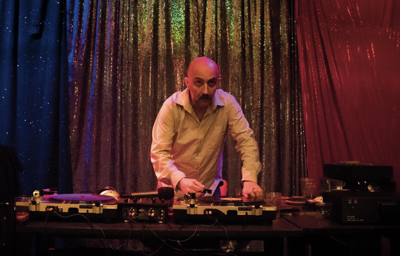
Gaspar Noé
Gaspar Noé isn’t just one of the more infamous bad boys in contemporary global art cinema, but it’s certainly OK if that’s how you know him. In five features, he’s chronicled human behavior at its most raw and wrenching, but also at its kindest and most deeply effective.
Noé had his first feature Seul Contre Tous/I Stand Alone (1998) under his belt before he got swept up in the glorious tsunami of political excess that was the New French Extremity back in the early Aughts. Irreversible (2002) was a phenomenon that even people who’ve not yet seen it know of by reputation and infamy. Since then, Noé has continued to explore the human experience in all its forms, with the psychedelic death trip of Enter the Void (2009) and his 3D sex drama Love (2015), helping lead the way for his newest film, Climax, a tragedy about what happens when a troupe of 20-something dancers gets dosed and their defenses start disintegrating. (Stay tuned for our review of that in tomorrow's dead-tree edition of the Scene.)
Noé spoke to the Scene via phone in preparation for Climax's opening Friday at the Belcourt.
For this film, you operated your own camera. In addition to all the planning that you have to do as a director, how do you prepare for something that physically demanding?
First of all, you have to find a light camera. When I made Love, we had to shoot with the 3D camera, which was very heavy. So you have to get the lightest camera that you can use. For every scene, I would let the dancers find their places, and I would observe and see where I could fit the camera and turn it around. And I also cheated a little — I shot with a larger lens than what you can see on screen, so that we could reframe it tighter as need be, so if someone moved too quickly I could reshape the image in the ’scope frame.
Sort of how they would do shooting Super 35 back in the ’90s.
With film shoots, shooting takes of this length, you would keep loading and unloading the film magazine. And I like the organic touch and look of Super 16 and 35mm, but now with digital you can always, in post-production, just add grain and texture. You can shoot extended takes and it’s less stress on the cast.
There’s something about dance films that lend themselves to digital — even Robert Altman did it for The Company.
I also worked with my favorite cinematographer, Benoit Debie [Spring Breakers, Il Cartaio, The Beach Bum], who built all the lights into the set so that you could frame the film in any part of the location. That way, you’re not blocking people from certain positions because the lightstand happens to be here or there. I went to film school and studied cinematography, and I know how traditional cinematography requires storyboards, and assembling your frame first, then lighting around that. But I want the characters to be able to roam freely around the space, and to do that you have to keep the lights out of the way. It also helps when you’re working with nonprofessional actors, because you don’t have all these obstacles, and a crew behind the camera, and it can be hard to concentrate and just let yourself be part of the movie that you’re in.
So what can you tell us about working with Kiddy Smile, who plays Daddy, the film’s DJ/moral center? I'd heard his song "Teardrops in the Box" a couple of years ago, but your film is his first major exposure in the U.S.
He’s very, very tall. And fascinating visually. In France, he’s one of the most famous parts of the voguing scene, and he’s DJing everywhere, and as a performer he’s invited to play everywhere like, every other day. And he helped me a lot with the movie at the very beginning, introducing me to the very best voguers, including some of the dancers who initially weren’t sure about appearing on screen. He was a father figure both in front of the camera and behind it. He made a lot of this movie happen that wouldn’t necessarily have happened.
Early on, this project was going to be called Psyche. Given how her character ends up, was there a specific meaning meant to be attached to her?
She’s not meant to be a more positive or negative character than any of the others; I love all the characters the same. But I thought it made sense to show what she’s been up to. She’s from Germany, and I don’t know if you’ve ever been there, but in Berlin there’s a club called the Berghain. It is the craziest club in the world, and I thought it made sense to have someone coming away from that part of the world. It’s also why one of the tapes alongside the interview sequence is "Inauguration of the Pleasuredome," to prepare the viewer for that kind of cinematic experience.
You can’t go wrong with Kenneth Anger. One of the fun things for me was madly taking notes during that sequence to try and remember what all tapes were alongside the right of the image.
Like the one on the very top, Le Droit Du Plus Fort, which translates as “The Right of the Citizen,” but it’s the French title for Fassbinder’s Fox and His Friends.
Yes, like Labyrinth Man is Eraserhead. It was fascinating to discover some of the titles that films I knew had been released under.
Unfortunately, when I shot that, I did not have the VHS tapes of Shivers, by David Cronenberg, which is very much of the themes of this film, and I didn’t have The Towering Inferno, because if there was one genre that this movie belonged to, it would be like that.
It is like a ’70s disaster movie. It never occurred to me, but it actually makes perfect sense.
I remember when The Towering Inferno came out, and I would watch it twice a week. I love the movies with all these perfect people, and they’re drinking Champagne or they’re on a boat, and they’re all going to die. The building will burn, or the boat is going to sink. But what I didn’t like is that in the American movies the good people are always going to survive, and the bad people always die. So I wanted to change that.
I can’t imagine the music licensing for this film was very fun for you. It’s a great soundtrack as it is, but were there other titles that you wanted but couldn’t get?
I love the music of Midnight Express by Giorgio Moroder. But because the rights were reserved by the producers who made that film, we couldn’t get that. And there were some other tracks that we couldn’t use because during the ’80s and ’90s there was so much sampling going on and everyone was getting sued. There’s all these classics voguing tracks that are technically illegal and impossible to license.
Sample credits and licensing are such a Byzantine part of the music industry, and it’s wild that you couldn’t get that Moroder piece, because what you do with the Moroder that you could license — 1977’s “Utopia, Me Giorgio” — in that final, red-bathed sequence in the rehearsal hall, is just staggering. That song is so "up," and majestic, and major-key, and it contrasts so wrenchingly with what’s happening onscreen.
Originally for that scene, I wanted to use this piece by Throbbing Gristle, but when you see these dark images with this dark music, it all felt too evident, and I thought it was better just to use an obsessional disco track, for the contrast. Like Kenneth Anger’s Scorpio Rising.
Appendix: The VHS tapes alongside the the interview screen toward the beginning of CLIMAX, should you want to do some homework before seeing it, are as follows.
Le Droit Du Plus Fort/Fox and His Friends
La Maman et la Putain/The Mother and the Whore
Possession
Salò, Ou Les 120 Journees De Sodome
Un Chien Andalou
Querelle
The Inauguration of the Pleasuredome
Harakiri No. 1 (a video magazine tied to what eventually became Charlie Hébdo)
Suspiria
Zombie/Dawn of the Dead
Schizophrenia/Angst
Labyrinth Man/Eraserhead





